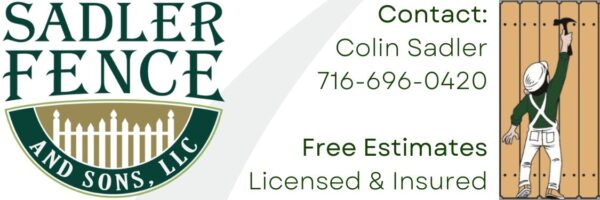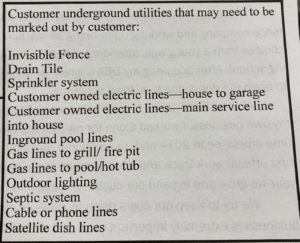Our standard procedure for fence installations:
1) Legalities:
• Is a Fence Permit required by town or city?
• Is a Variance needed for placement, height, or style of the fence?
• Local Fence Codes
2) Call Dig Safe NY (811)
• A number of utility companies will come out and mark any major underground utilities present in the work area.
• This is a free call and should be done by anyone who is planning on digging or “breaking the sod” (gardens, fences, decks, etc)
• This is done to ensure the safety of the people doing the excavation work and also protect the integrity of underground utilities
• Locations of personal underground utilities (sprinkler systems, drainage tile, other) also must be marked *by the customer* before any digging begins.
3) Property line guidelines:
• Find property lines by using a property survey.
*We always install the outside edge of a fence at least 2-3 inches inside of property line in order to avoid future property disputes. Some localities may require 6 inches inside.
*Concrete surrounding fence posts underground must be completely located on customer’s property
4) Removal of existing fence (if necessary):
• Remove any existing fence panels, rails, and pickets.
• Remove any existing posts that will interfere with new installation (ex. end posts and corner posts)
• Remove “in-line” fence posts by cutting off below ground level or totally removing (old post footing will remain underground unless removal is necessary).
5) Installation of new fence:
• Dig and set end posts and corner posts in concrete. This step determines the general height of the bottom of the fence off the ground (standard is 1-3 inches)
• Set up string line to determine grading and final location of fence. This step is very important and requires some input from customer, – (how should the fence flow? Should the installed fence end up level or run uphill or downhill with a changing grade?).
• Mark string line where “in-line” posts will be installed
• Dig holes for line posts – if using power equipment, trim holes
• Set “in-line” posts in wet cement (if installing 4 foot high chain link, line posts are driven into the ground with a post pounder – no digging holes required)
• At this point time is usually allowed for the concrete to “set-up” – the length of this wait can be anywhere between a few hours and a full day or even two depending on a couple variables (how wet is the ground? Is the weather hot and dry? How much weight is being attached to new posts? Does the customer need access to the yard before it is fully enclosed?)
6) Panel installation/assembly:
• The final assembly of each different style of fence varies.
• With chain link fence, cross rails and wire is attached and then tied to the new posts.
• With some types of aluminum fence, aluminum fence panels are inserted into “punched” holes in each post. That process would take place as each “in-line” post is set. Brackets are attached to each post and panels are then installed between each bracket set.
• With privacy vinyl fence, a bottom rail and top rail is pushed into each post and pickets are installed. Semi-privacy vinyl panels are sometimes assembled in a factory before shipping and these are simply inserted into the routed holes in each fence post. Other styles come unassembled and in those cases rails and then pickets are individually installed. After panels are installed, post caps are installed using silicone.
• With wooden fences, panels can be assembled in a factory then brought to the jobsite and attached to the new posts with screws or nails. Another method involves delivering individual materials to the jobsite and “stick-building” the fence. A “stick build” means that cross rails are attached to each post at predetermined heights and then each picket is attached to the cross rails one at a time using a pneumatic nail gun.
7) Fence installation timing
A fence can be installed at any time of the year (yes, even in the harsh winter months in WNY). One of the main considerations when installing a fence during winter months is making sure the concrete holding the fence posts up is able to cure correctly. We prefer using high strength concrete mix. Follow this link to see all their technical recommendations.
To give you the basics;
• The temperature of the water used to mix the concrete is one variable which determines how fast the concrete will set up.
• We add a product called Thermo-lube® to concrete mix in colder weather in order to ensure uniform setting and curing conditions.
• It typically takes concrete about 28 days for a full-cure in most weather conditions, even though working strength may be achieved within a few hours after mixing.
There are always some considerations for the best timing to install a fence.
What is the condition of the yard? If the yard is too wet, the project of installing a fence can cause quite a mess.
Are there high winds in the forecast? If so, the posts should be given extra time to set up before attaching weight to them.


Pingback: Can I upgrade my pre-existing fence with modern fence materials? « Hercules Fence Washington DC Hercules Fence Washington DC